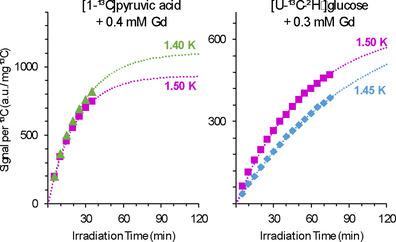当前位置:
X-MOL 学术
›
ChemPhysChem
›
论文详情
Our official English website, www.x-mol.net, welcomes your feedback! (Note: you will need to create a separate account there.)
The Effect of Gadolinium Doping in [13 C6 ,2 H7 ]Glucose Formulations on 13 C Dynamic Nuclear Polarization at 3.35 T.
ChemPhysChem ( IF 2.9 ) Pub Date : 2020-01-10 , DOI: 10.1002/cphc.201900946 Talia Harris 1 , Ayelet Gamliel 1 , Atara Nardi-Schreiber 1 , Jacob Sosna 1 , J Moshe Gomori 1 , Rachel Katz-Brull 1
ChemPhysChem ( IF 2.9 ) Pub Date : 2020-01-10 , DOI: 10.1002/cphc.201900946 Talia Harris 1 , Ayelet Gamliel 1 , Atara Nardi-Schreiber 1 , Jacob Sosna 1 , J Moshe Gomori 1 , Rachel Katz-Brull 1
Affiliation

|
The promise of hyperpolarized glucose as a non‐radioactive imaging agent capable of reporting on multiple metabolic routes has led to recent advances in its dissolution‐DNP (dDNP) driven polarization using UV‐light induced radicals and trityl radicals at high field (6.7 T) and 1.1 K. However, most preclinical dDNP polarizers operate at the field of 3.35 T and 1.4–1.5 K. Minute amounts of Gd3+ complexes have shown large improvements in solid‐state polarization, which can be translated to improved hyperpolarization in solution. However, this Gd3+ effect seems to depend on magnetic field strength, metal ion concentration, and sample formulation. The effect of varying Gd3+ concentrations at 3.35 T has been described for 13C‐labeled pyruvic acid and acetate. However, it has not been studied for other compounds at this field. The results presented here suggest that Gd3+ doping can lead to various concentration and temperature dependent effects on the polarization of [13C6,2H7]glucose, not necessarily similar to the effects observed in pyruvic acid or acetate in size or direction. The maximal polarization for [13C6,2H7]glucose appears to be at a Gd3+ concentration of 2 mM, when irradiating for more than 2 h at the negative maximum of the DNP intensity profile. Surprisingly, for shorter irradiation times, higher polarization levels were determined at 1.50 K compared to 1.45 K, at a [Gd3+]=1.3 mM. This was explained by the build‐up time constant and maximum at these temperatures.
中文翻译:

[13 C6 ,2 H7 ]葡萄糖配方中钆掺杂对 3.35 T 下 13 C 动态核极化的影响。
超极化葡萄糖作为一种能够报告多种代谢途径的非放射性成像剂的前景已经导致其溶解-DNP(dDNP)驱动极化的最新进展,该极化使用紫外线诱导的自由基和三苯甲基自由基在高场(6.7 T)和 1.1 K。然而,大多数临床前 dDNP 偏振器在 3.35 T 和 1.4-1.5 K 的场中工作。微量的 Gd 3+配合物显示出固态极化的巨大改进,这可以转化为改进的溶液中的超极化。然而,这种 Gd 3+效应似乎取决于磁场强度、金属离子浓度和样品配方。已经描述了在 3.35 T下改变 Gd 3+浓度的影响13C-标记的丙酮酸和醋酸盐。然而,该领域尚未对其他化合物进行研究。此处显示的结果表明,Gd 3+掺杂可导致对 [ 13 C 6 , 2 H 7 ] 葡萄糖极化的各种浓度和温度依赖性影响,在大小或方向上不一定与在丙酮酸或乙酸盐中观察到的影响相似. [ 13 C 6 , 2 H 7 ] 葡萄糖的最大极化似乎在 Gd 3+当在 DNP 强度分布的负最大值下照射 2 小时以上时,浓度为 2 mM。令人惊讶的是,对于更短的照射时间,在 [Gd 3+ ]=1.3 mM 时,在 1.50 K 处确定了与 1.45 K 相比更高的极化水平。这可以通过在这些温度下的建立时间常数和最大值来解释。
更新日期:2020-01-10
中文翻译:

[13 C6 ,2 H7 ]葡萄糖配方中钆掺杂对 3.35 T 下 13 C 动态核极化的影响。
超极化葡萄糖作为一种能够报告多种代谢途径的非放射性成像剂的前景已经导致其溶解-DNP(dDNP)驱动极化的最新进展,该极化使用紫外线诱导的自由基和三苯甲基自由基在高场(6.7 T)和 1.1 K。然而,大多数临床前 dDNP 偏振器在 3.35 T 和 1.4-1.5 K 的场中工作。微量的 Gd 3+配合物显示出固态极化的巨大改进,这可以转化为改进的溶液中的超极化。然而,这种 Gd 3+效应似乎取决于磁场强度、金属离子浓度和样品配方。已经描述了在 3.35 T下改变 Gd 3+浓度的影响13C-标记的丙酮酸和醋酸盐。然而,该领域尚未对其他化合物进行研究。此处显示的结果表明,Gd 3+掺杂可导致对 [ 13 C 6 , 2 H 7 ] 葡萄糖极化的各种浓度和温度依赖性影响,在大小或方向上不一定与在丙酮酸或乙酸盐中观察到的影响相似. [ 13 C 6 , 2 H 7 ] 葡萄糖的最大极化似乎在 Gd 3+当在 DNP 强度分布的负最大值下照射 2 小时以上时,浓度为 2 mM。令人惊讶的是,对于更短的照射时间,在 [Gd 3+ ]=1.3 mM 时,在 1.50 K 处确定了与 1.45 K 相比更高的极化水平。这可以通过在这些温度下的建立时间常数和最大值来解释。


























 京公网安备 11010802027423号
京公网安备 11010802027423号